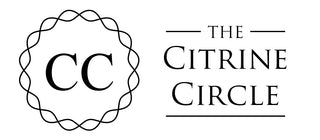Citrine is a crystal that is well known to many people, it's sunny energy and popularity as a crystal that attracts prosperity and abundance makes it a firm favourite among many. What you might not know however, is that about 95% of the Citrine on the market is actually heat treated Amethyst, or "fake" Citrine. To create heat treated Citine (also called burnt Amethyst), an Amethyst crystal is baked at temperatures of around 800-900 degrees Farenheit, this changes the colour to deepening shades of orange, depending on how long it is "cooked" for.

It can be quite difficult at first to know what you're buying, as most shops don't label their crystals as heat treated Amethyst, and even now, many crystal authors still have photos of burnt Amethyst crystals labelled as Citrine. Once you learn a few key points however, you will easily be able to tell them apart.
1. The Main Colour
Natural Citrine can vary from a very pale yellow shade, almost green in colour, such as Congo Citrine (also called Kundalini Citrine), to a stronger deep, often smokey yellow such as the long crystals from Zambia. Natural Citrine is hardly ever a deep burnt yellow-orange colour, this is almost always burnt Amethyst, although there are exceptions.
2. The Base Colour
Natural Citrine crystals are the same colour all the way through for the most part, though there may be slight colour variations in the crystal. Heat Treated Citrine will often have opaque white in it, usually at the base, which is a tell-tale sign of a heated crystal due to it's original Amethyst form.
 3. The Crystal Formation
3. The Crystal Formation
Natural Citrine tends to grow in single crystals or small clusters of a few crystals, and never in a geode form. You will often see geodes of varying sizes that look suspiciously like orange Amethyst, this is exactly what they are.
Here are some images of Citrine being sold by retailers that are actually ALL heat treated Amethyst:

Notice how the bright orange/yellow colour is not even, there is the white base of the crystal, and that the formations look exactly the same as an Amethyst crystal?
Here are some pictures of Natural Citrine from different regions:

Notice how the colour of these Citrine crystals is much lighter and more of a greeny shade? The first and last pictures are Citrine from the Congo, the second picture is Citrine from Zambia, two of the most famous natural Citrine localities.
All of the Citrine we sell is natural, and mostly from the Congo and Zambia. Many crystal healers say it doesn't matter whether your Citrine is natural or heat treated Amethyst, but personally I believe that both Citrine and Amethyst are amazing crystals in their natural forms, and I would rather have them in the colour nature created them. Hopefully this article has helped to show the difference between the two crystals, if it has, please share it to help spread the knowledge!


 3. The Crystal Formation
3. The Crystal Formation
Anthony Bonelli
I recently bought a “Citrine Hydro Gemstone”, but everything I have been reading has left me confused. Please tell me if this Gemstone is real Citrine or not, I need an answer, thank you for your time and patience.
RR
Citrine
Sara
My piece of citrine is clear with only a few spots of light yellow and little bit of a yellow tint around the spots. It doesn’t really resemble either of the pictures so I’m not sure what mine is.
Kaleigh
Well this is upsetting. I LOVE citrine while amethyst literally gives me negative physical reactions. It feels so icky and heavy to me while citrine feels light and energizing. To the extent that I heavily avoid amethyst and have given away every piece of it from my collection. But now I am pretty sure the two pieces of “citrine” that I own may be amethyst and I don’t know what to do with this information. These two pieces always felt like citrine but now looking at them I feel like I have been deceived.
Suzi Johnson
I have a citrine that seems to be a lite honey color. No white, just lighter in some areas, about 2 1/2 inches long, no particular top or bottom and natural shape. When held to light it is darkest in the center